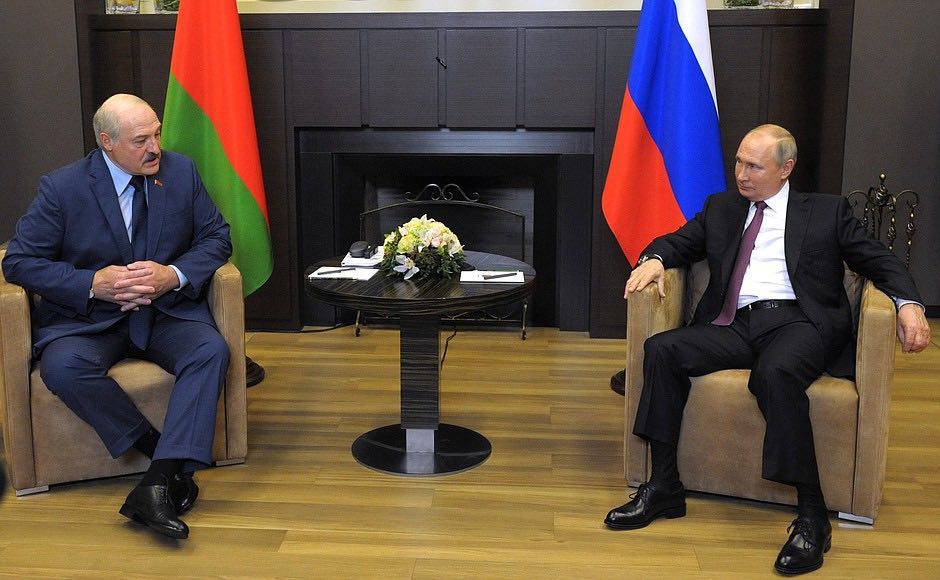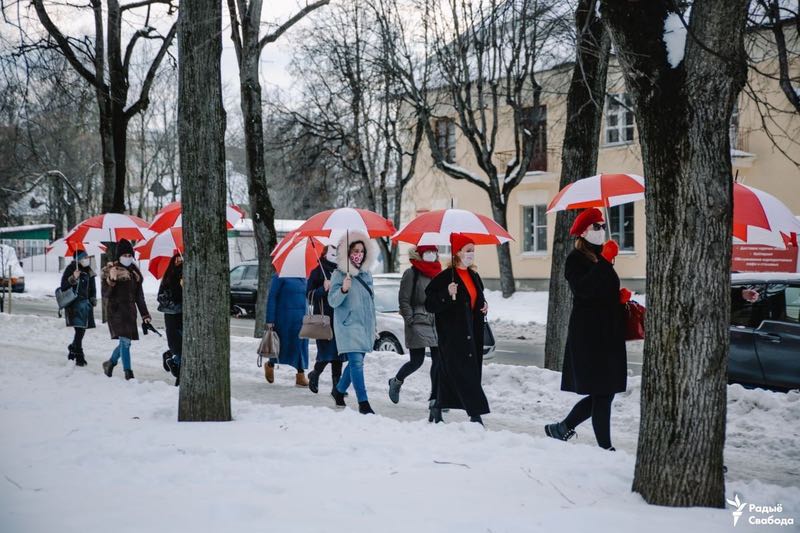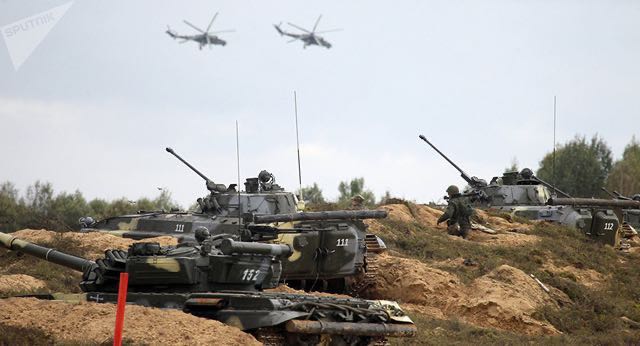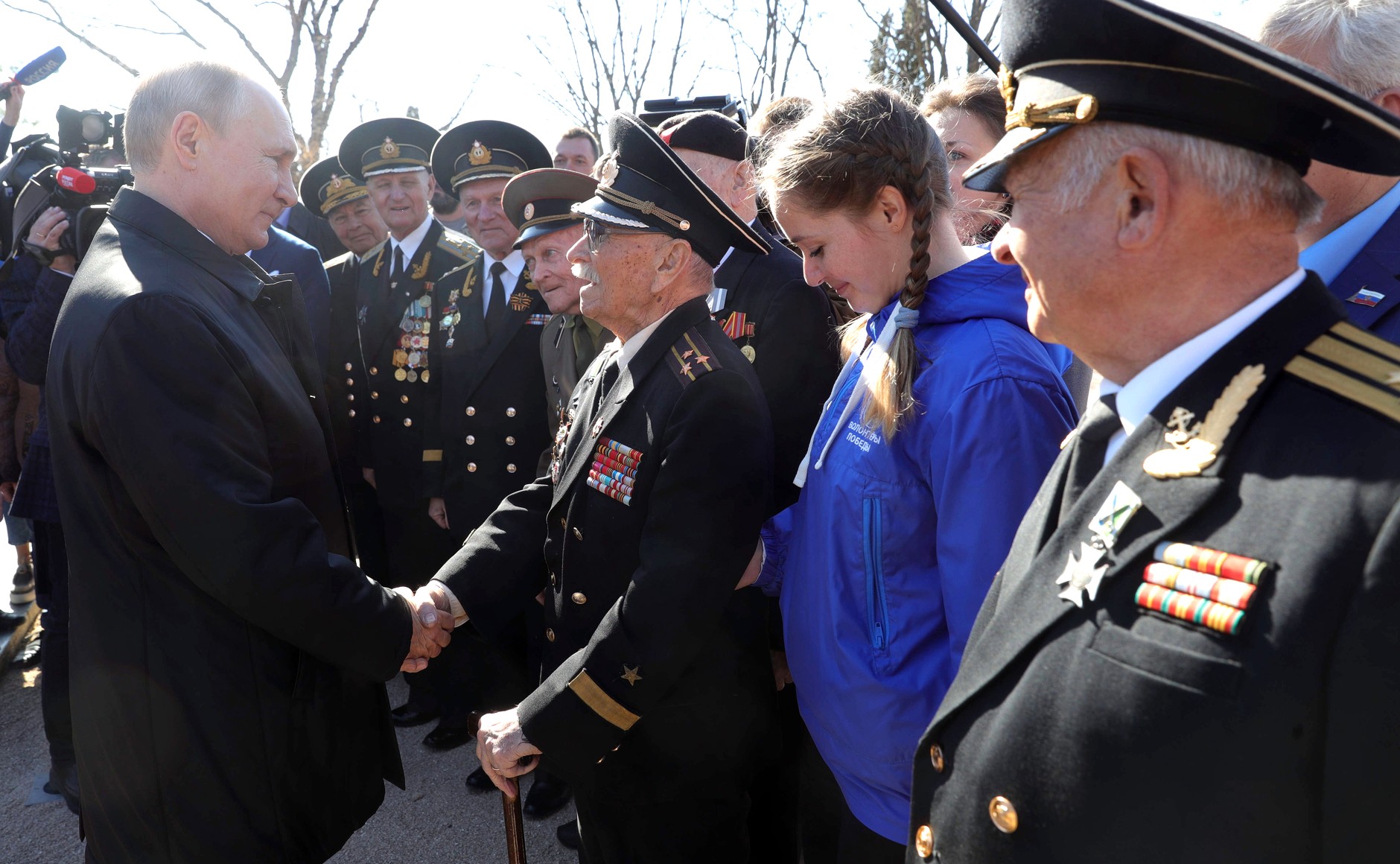After the Russian annexation of Crimea in 2014 many feared that this 'compatriot protection scheme' could become a precedent. Which post-Soviet republic with a sizeable Russian-speaking population would be the next ‘domino’? This master thesis of Tijs van de Vijver looks for equivalents in the case of Belarus. Based on Marlene Laruelle’s study of Russian secessionism in Kazakhstan, the author concludes that conditions in Belarus – the lack of focus of ‘compatriot issues’ in Russia-Belarus relations, the difficulty of delineating a ‘Russian part’ of Belarus and its population, and the lack of a grassroots organizational framework – are ultimately unfavorable to Russian-sponsored secessionism. The national uprising after the election fraud of August 2020 proved to be a gamechanger as well.
 Putin and Lukashenka regularly meet in Sochi to discuss possible merging of Belarus and Russia (picture Kremlin)
Putin and Lukashenka regularly meet in Sochi to discuss possible merging of Belarus and Russia (picture Kremlin)
by Tijs van de Vijver
After the Russian annexation of Crimea in 2014, academic and popular interest in Russia's 'compatriot protection' surged. Fears that 'Crimea' constituted a precedent rather than an isolated incident were common, with journalists and scholars going to lengths in arguing which post-Soviet republic with a sizeable Russian-speaking population would be the next 'domino' in the 'domino effect' that the annexation of Crimea was supposed to bring about. After all, Russia justified its military involvement in the secessionist cause in Crimea at least partly by its commitment to the protection of 'compatriots' in the post-Soviet space, and more countries bordering Russia are home to sizeable groups of Russian speakers.
For several reasons - such as geographic and cultural proximity, but also a sizeable Russian-speaking population - Belarus has repeatedly been cast as ‘the next Crimea.’ Such claims gained a new dimension when nationwide protests broke out against Belarusian President Aliaksandr Lukashenka around the August 2020 Presidential elections. Russia would use the instability caused by the protests as an inducement to interfere in (parts of) the country to pacify the country or these regions, just as it had attempted in Ukraine in 2014.
Since 2014, however, Russia has not come to interfere in Belarus or any other post-Soviet state or region with a considerable population of ‘fellow Russians.’ This has prompted critics like Laruelle (2018) and Melyantsou (2021) to revisit the mentioned ‘domino effect’ by demonstrating how conventional accounts often fail to take into account or mischaracterize the agency of groups of Russians and Russian speakers outside Russia, the agency of ‘host states’ in accommodating to the needs of the Russians and Russian-speakers, the dynamics of the relationship between Russia and the individual republics, and several other factors of significance. This thesis aims to conduct a similar exercise, turning to the case of Belarus.
Russian Compatriots & Belarus
The twenty-five million Russians that found themselves outside the Russian Federation after the downfall of the Soviet Union in 1991 have come to hold a contentious albeit ambivalent position in the domestic and foreign politics of the post-Soviet republics over the past three decades. In aiming to prevent antagonizing the Russian Federation - an increasingly vocal advocate for the rights of Russians outside Russia over the past three decades - the newly independent states of the post-Soviet space had to find a way to include communities of Russians and Russian-speakers in state- and nation-building policies on, for example, the adoption of national symbols and official languages, while also dealing with calls for regional autonomy and the conditions of post-Soviet citizenship.
Over the past three decades, the Russian authorities have increasingly cast ‘Russians’ outside Russia as ‘compatriots.’ The label has evolved into an increasingly wide, but well-defined concept over Putin’s presidency, so that - rather than opting for a narrower definition based on more objective factors such as language, religion, or having a Russian passport - the label now fits anyone who feels any sense of belonging to the Russian nation, or whom Russia deems Russian.
In 2014, ‘compatriot’ legislation and rhetoric were employed to legitimize the Russian intervention in Crimea. In turn, the intervention in Crimea boosted Russia’s international confidence, so that it was feared by many that the Russian intervention in Crimea would not amount to an isolated incident. It was feared that over the following period, ‘fellow Russians’ in other countries of Eurasia would, too, seek and receive Russia’s support for a secessionist cause - with Belarus often cited as a prime example.
Laruelle's Framework
The actual likelihood of a ‘domino effect’ of ‘Crimea’ in the case of Belarus, however, has thus far remained largely unaddressed. In aiming to delve into this hiatus, this thesis applies Marlene Laruelle's analytical framework for assessing Russian-inspired secessionism in Kazakhstan onto the case of Belarus. In her article, Laruelle put apparent comparisons between Ukraine and Kazakhstan - a country often argued to be facing a similar fate as Ukraine, mostly on the basis of it being home to a sizeable group of ‘compatriots’ - under a magnifying glass.
 Women play an important role in the Belarusian uprising
Women play an important role in the Belarusian uprising
Laruelle identified the three dominant schools of analysis in the rich literature on post-Soviet Russian-inspired secessionism that, when taken together, shape a broad explanatory framework. Laruelle’s three schools take into account (i) Russia’s role as an external actor in fuelling secessionist movements in a post-Soviet ‘host state,’ (ii) certain historical, demographic, and societal elements as co-determinants of the likelihood of success of the secessionist movements, and (iii) the role of local grievances, local elites, and local narratives.
By combining these three schools of analysis to the case of the ‘compatriots’ in Kazakhstan, Laruelle finally exposes the shallowness of theories that propose a Crimean ‘domino effect’ occurs in Kazakhstan, ultimately arguing that “the risk of Russian secessionism in Kazakhstan is largely hyped.”
The External Factor
Laruelle’s first school of thought focuses on ‘the external factor,’ or Russia’s role in inciting secessionism among ‘fellow Russians’ abroad. Laruelle argues that Moscow’s ‘activation’ of ‘compatriots’ to stir up secessionism is more likely to occur when the relationship between the host state in question and Russia is more problematic, with Russia ‘activating’ ‘compatriots’ in local conflicts in Ukraine’s Donbas and Crimea, Georgia’s South Ossetia and Abkhazia, and Moldova’s Transnistria often cited as prime examples.
There is currently little reason to suspect that Belarus will drift away from Russia’s orbit like Ukraine did in 2014. After all, Belarus has joined virtually all Russian-led international projects like the EAEU and the CSTO since 1991, while it plays a pivotal role in the transit of Russian natural resources going to Europe. Moreover, the country continues to play an important role in Russian military-strategic thinking, given that it directly borders NATO and is part of the shortest land route to Kaliningrad, to which Belarus’ participation in the recent/ongoing Zapad-2021 military exercise in Russia attests.
Some, however, have cast Belarus as an ‘unreliable partner’ to Russia, posing that Belarus has sought to decrease its dependence on Russia over recent years by seeking a rapprochement with Brussels and/or Washington. This argument gained another dimension with the ongoing anti-government protests that sprung up across Belarus around the fraudulent Presidential elections in August 2020: the use of the Belarusian language by many in the democratic movement, as well as the use of alternative national symbols, would imply that the Belarusian democratic movement will pursue a more exclusionary nationalist policy agenda, while also seeking to change Belarus’ current relationship with Russia.
 Belarus and Russia regularly hold joined military drills. It is a sign of ever closer cooperation and integration. This makes a Crimea scenario highly unlikely.
Belarus and Russia regularly hold joined military drills. It is a sign of ever closer cooperation and integration. This makes a Crimea scenario highly unlikely.
Nonetheless, despite the occasional Belarusian ‘flirts’ with Brussels and despite concerns that a new Belarusian leader would seek to move Belarus away from Russia, there remains a wider shared sentiment that the relationship between Belarus remains close almost to an unparalleled degree.
Following Laruelle’s reasoning, the combination of this close relationship with the currently virtually unthreatened position of the Russian language and the strong position of its speakers in Belarusian society implies that the tremendous cost and uncertain benefits of influencing Belarusian politics by ‘activating’ ‘fellow Russians’ would not outweigh the likely economic instability and political turmoil. This suggests that it is it highly doubtful whether such an ‘activation’ will occur in the foreseeable future.
The ‘Russianness’ of Belarus
Pundits also point to certain historical, demographic, and economic fundamentals as co-determinants of Russian secessionism in Eurasia, arguments that Laruelle categorizes as ‘the second school of thought.’ For several reasons, then, I suggest that Crimea’s ‘Russianness’ is not mirrored by Belarus as a whole, nor by any of its regions separately.
Following Laruelle, the position of Belarus in Russian history and public opinion is vastly different from Crimea’s. Similar to Kazakhstan, “there is no “gift from Khrushchev” to mourn, [while] the “Russianness” of [Belarus] cannot be embodied in a famous city whose mere mention would spark a rally-around the flag movement in Russia.” This may be reflected in opinion polls conducted by the Levada Center, which reveal that there is little societal support for closer integration in the Russo-Belarusian Union State in Russia (11%), and that there is little support for annexing Belarus into the Russian Federation (13%) - which stands in sharp contrast with the relatively stable support for the annexation of Crimea of approximately 85% that has been observed in Russia over the past seven years.
Secondly, even though Belarus is home to a sizeable group of Russians and Russian-speakers that may suit the ‘compatriot’ label, a glance at Belarusian census data and Belarusian history make it problematic to distinguish a sizeable ‘Russian minority’ or a distinct ‘Russian part’ of the country being different from a ‘Belarusian majority’ or a ‘Belarusian part’ as has commonly been done in Ukraine.
 Putin visits Crimea every year. After the annexation his ratings soared to more than 80 percent.
Putin visits Crimea every year. After the annexation his ratings soared to more than 80 percent.
Grassroots Russian Activism in Belarus
Laruelle’s third school of thought is concerned with grassroots activism, local grievances, and the role of ‘minority elites’ as co-determinants of secessionist movements’ potential for success, because “often the low or failed legitimacy of the central government […] may be one of the “push” factors for secessionism.” Laruelle demonstrates how Kazakhstani Russians came together to advocate for their position over the early 1990s, but also how the group overwhelmingly slid into depoliticization over more recent decades, concurrent with the more general autocratic turn in Kazakhstani politics.
Local chapters of the Russkiy Mir Foundation, Rossotrudnichestvo, and numerous local compatriot organizations registered with the Russian embassy together form the bulk of the associative landscape of Russians and Russian speakers in Belarus. These organizations can hardly be said to amount to a political voice for Russia’s ‘compatriots’ in Belarus, considering that the scope of the activities of The Russkiy Mir Foundation and local ‘compatriot organizations’ is limited to the fostering of cultural elements of ‘Russianness.’ Moreover, these organizations have limited success in reaching younger people, considering that younger generations do not as strongly attach value to the shared experience and nostalgia for the common Soviet history of Russia and Belarus. Lastly, the mentioned organizations are state-led or state-sponsored, and have been described as “tools of Russian intelligence,” making it problematic to speak of grassroots organizations that genuinely aim to empower Russians and Russian-speakers in Belarusian politics and society.
Additionally, Belarus currently lacks a sense of regional Russian activism similar to what Ukraine had witnessed before 2014. Belarus’ smaller territory, but also the centralization of power around Lukashenka makes it difficult to argue that Belarus’ regions or regional political elites compete for political leverage: there are no recorded calls for regional autonomy in Belarus, while none of the organizations mentioned above specifically focus on the cultural identity or political autonomy of one of Belarus’ regions.
It may thus be argued that the ‘Russian compatriots’ of Belarus have become as depoliticized as those in Kazakhstan – if Belarus’ Russians should even be regarded as having constituted a distinctive political force at some point to begin with. Since there is no major political party or major regionally active movement that currently advocates for the position of ‘compatriots’ in Belarus, the organizational capabilities and political leverage of ‘compatriots’ are seriously limited in Belarus.
Conclusion
Many feared that the intervention in Crimea on the pretext of ‘compatriot protection’ would cause some sort of ‘domino effect.’ Fears that ‘Crimea’ would be replicated elsewhere in Eurasia have thus far not materialized, causing scholars like Laruelle to revisit the likelihood of a ‘domino effect’ for specific countries, as well as the general likelihood of such a ‘domino effect.’
Ultimately, despite obvious and serious reservations, the nature of the relationship between Russia and Belarus is such that it is currently of little interest for Moscow to ‘activate’ its ‘compatriots’ in that country. Secondly, ascribing to Belarus a similar degree of Russianness that has commonly been ascribed to Crimea is problematic as well. Third, Laruelle demonstrated the importance of some sort of grassroots activist framework for secessionist movements to succeed – a factor that seems to be largely absent in Belarus. This thesis ultimately suggests that any prospect of Russia-sponsored secessionism in Belarus is, just as Laruelle argued in the case of Kazakhstan, ‘largely hyped.’
Read the master thesis in full here.
